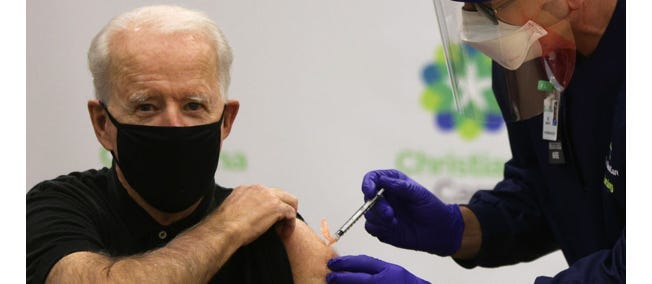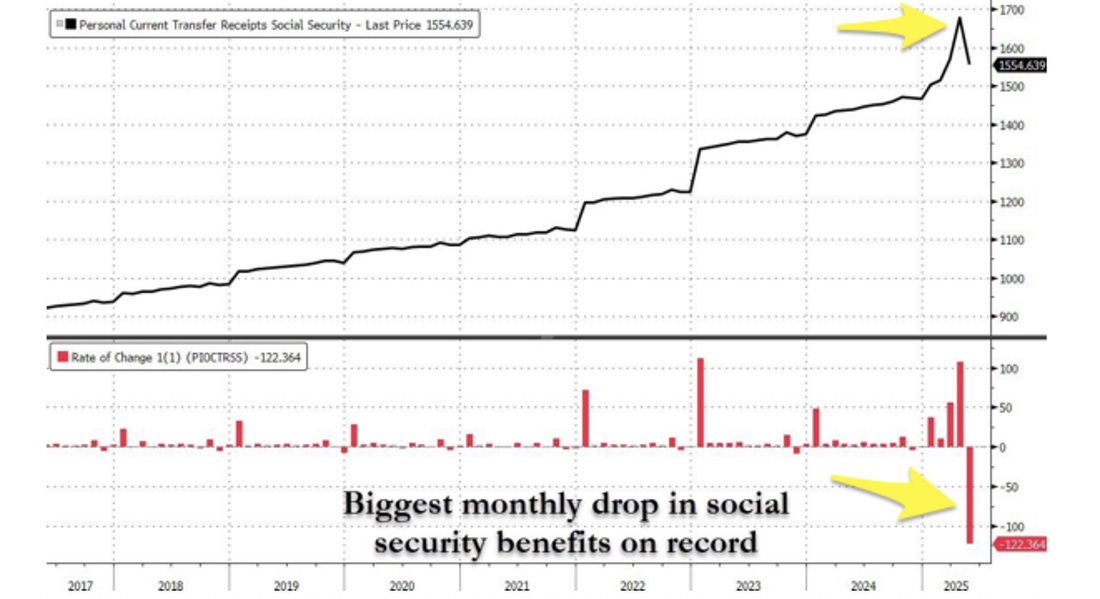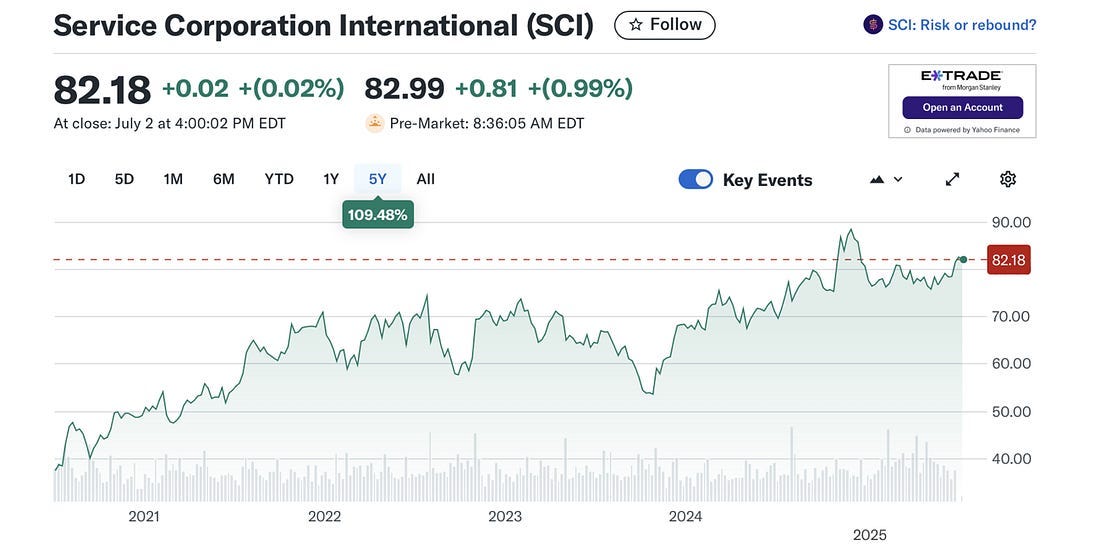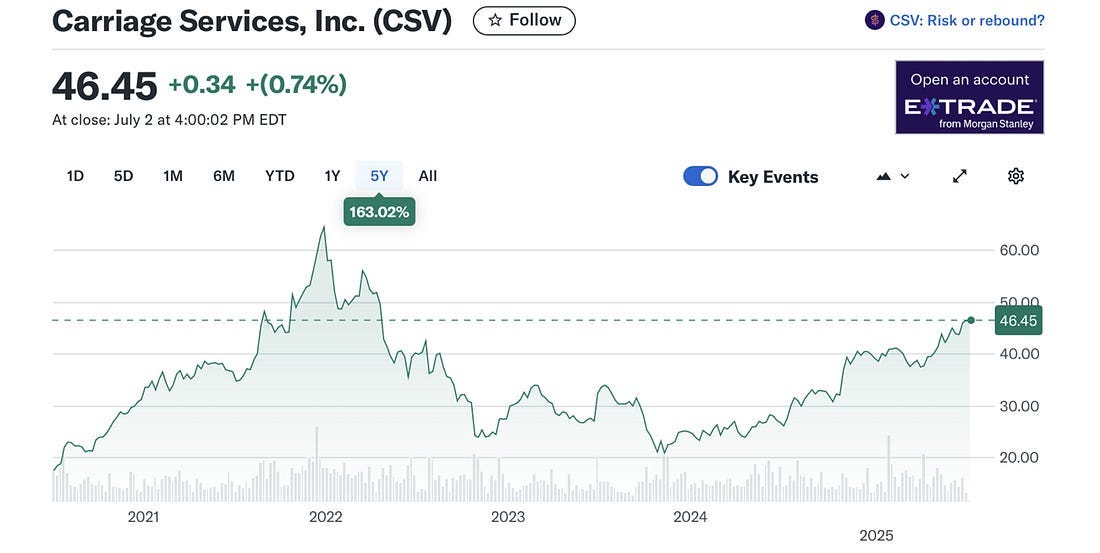Richard C. Cook comments: The evidence grows daily that the COVID “jab” was/is a bioweapon of genocidal intent. Writing in C&C News, attorney Jeff Childers is super-cautious about drawing conclusions on such topics. But the facts can no longer be hidden. Fair Use Claimed.
Special Three Sages book promotion
Richard C. Cook, Our Country, Then and Now. ORDER HERE
Fadi Lama, Why the West Can’t Win: From Bretton Woods to a Multipolar World. ORDER HERE
Dr. Lewis Coleman: 50 Years Lost in Medical Advance: The discovery of Hans Selye's stress mechanism. ORDER HERE
From C&C News, “Sudden and Unexpected” by Jeff Childers, July 3, 2025. Click Here.
I will now depart from normal C&C practice, and make a calculated leap of speculation with potentially vast implications. But recent evidence demands it. Yesterday, ZeroHedge ran a story headlined, “Centene Crashes Most On Record, Sparks Selloff In Managed Care Stocks.” This is not good news. It could be awful.
The managed care industry got carpet-bombed yesterday, after Centene Corporation, one of the largest health insurers in the U.S., suffered the worst single-day stock drop in its history—crashing up to 40% after yanking its 2025 guidance. The crash was caused by devastating new actuarial data showing that Centene’s Affordable Care Act (Obamacare) enrollees are sicker, costlier, and fewer than expected, especially in 22 states where Centene holds significant market share.
The company now faces an unexpected $1.8 billion hit to its 2025 earnings, triggering immediate Wall Street downgrades and a sector-wide investor panic. UnitedHealth had already slashed its forecast weeks earlier and replaced its CEO. Now, analysts warn that the Obamacare risk pool is unraveling, with spiking Medicaid costs and mispriced premiums dragging down the entire industry. Bluntly, insurers had bet on healthy growth— but have hemorrhaging patients instead.
Centene Corporation is one of the largest health insurance providers in the United States, specializing in government-sponsored programs like Medicaid, Medicare Advantage, and Affordable Care Act (ACA) marketplace plans. Headquartered in St. Louis, Centene serves over 28 million members (about a tenth of the entire country), primarily low-income and vulnerable populations. Its rapid rise came from aggressively expanding into public health contracts across dozens of states, making it a bellwether for the broader managed care industry. In short, Centene is a key pillar of the federalized U.S. healthcare safety net.
But the company’s explanations made the hair on the back of my neck stand up. They cited two “unexpected” developments. First, morbidity (sickness and permanent disability) is rocketing upwards. Seon, at the same time, their insured pools are shriveling. The loss of enrollees is, presumably, because of excess death. Why else would very sick people drop off free or heavily subsidized insurance rolls?
Centene’s clients are not typical MAHA folks who might be fleeing ACA for non-traditional healthcare. They are folks captured by government healthcare.
💉 Centene’s customers are possibly the most heavily jab-propagandized populations on planet Earth. Its core customer base includes Medicaid recipients, ACA exchange enrollees, and Medicare Advantage members. I.e., seniors and low-income, working-age folks. These are precisely the populations that faced the most aggressive vaccine outreach, were most subject to institutional mandates and incentives, and had the fewest options to resist or opt out.
Medicaid recipients were often required or heavily pressured to get vaccinated in order to keep jobs, access care, or participate in other public programs. ACA ‘marketplace’ enrollees, many of whom fall into the working-poor category, were heavily targeted by state-level campaigns. And Medicare Advantage members —primarily older adults— were at the front of the vaccine rollout line, with near-total uptake among those over 65.
If a long-term adverse event signal were associated with mass vaccination, Centene’s risk pool would necessarily be disproportionately exposed to that signal. Consider that with rapidly rising morbidity, shrinking enrollment, and a $1.8B actuarial shock —i.e., future forecasts of the same or worse— the implications become uncomfortably plausible.
The fact that Centene had to suddenly withdraw guidance —not revise, not adjust, but yank it entirely— and instead report a devastating $1.8 billion projected hole, based on new data from its auditors, suggests the trend was recent and sharp, not gradual. The scope or scale was unexpected— possibly exponential. Their previous assumptions were suddenly falsified in an astonishingly short timeframe.
That means the underlying risk landscape shifted materially, and fast.
💉 But even that unsettling news wasn’t what turned my blood to icy sludge. It was another dot that snapped right into place. On June 29th, I ran a different story, at that time describing a happy DOGE success story. The story was about the federal government’s new plan to claw back 50% of fraudulent Social Security overpayments, a welcome development. Here’s the thing: the clawbacks hadn’t started yet. But in my optimism, I decorated the story with this graph, which showed the largest drop-off in Social Security payments in history, starting this year:
So, this morning, as I considered Centene’s disaster story, my lawyer’s brain automatically clicked back to that surprising Social Security graph. Now, don’t get me wrong. It absolutely could be improved waste, fraud, and abuse tracking, as I’d supposed on June 29th. But … I was just guessing. The Administration hasn’t taken any victory laps claiming that historically reduced Social Security payments were the fruits of DOGE labor. Not officially or even unofficially. I was just trying to connect some dots.
But … what if there’s another explanation? What if the historic downward spike in Social Security payouts is because … there are suddenly a lot fewer seniors?
💉 I don’t want to make these kinds of connections. But after years of litigation training, I can’t help it. The Social Security chart is evidence that reinforces the Centene bombshell— a massive, actuarially driven revelation of sudden and unexpectedly high morbidity and shrinking insured populations in Medicaid and the ACA exchanges. Two entirely separate systems. Two different populations. One unmistakable pattern: rapidly shrinking rolls of government-dependent individuals, precisely as healthcare costs suddenly explode.
If large numbers of Centene’s clients are disappearing, and Social Security payouts are plummeting simultaneously, it’s not just plausible, it’s even likely that we’re seeing the same people vanish from two systems at once. Unlike the health insurance market, Service Corporation International (SCI), America’s largest provider of funeral services, cremations, and cemeteries, has climbed over 109% since 2021, and the latest trendline shows a renewed climb into 2025.
Carriage Services (CSV), another major player in the deathcare industry, is up an eye-watering 163% since the jab rollout started.
If we were searching for the early warning signs of an iatrogenic catastrophe on a national scale, this is exactly what it would look like.
In other words, if a significant portion of the population experienced subclinical injury or long-term health destabilization from a medical intervention (say, inflammation, clotting, immune dysregulation), then you’d expect a lag. Not immediate death, but a multi-year, slow-motion collapse, with inflection points stabbing when the weakest systems start to give out.
Years 2 to 4 post-intervention is prime time for that kind of morbidity to begin translating into mortality— especially in already-vulnerable populations like elderly, disabled, and immunocompromised.
So the sudden 6-month drop in Social Security payouts now, in 2025, is consistent with wave-one fatal outcomes starting to manifest en masse. And it matches Centene’s sudden and unexpected announcement, and the deathcare stocks acting like they’ve struck gold.
💉 Anecdotally, many independent public health watchers (myself included) have noticed a recent uptick in sudden and unexpected deaths and disabilities. Just yesterday, one of my high-profile, out-of-town mediations with a $100-billion hospital canceled on short notice, because the hospital’s tall building lawyer experienced a severe cardiac problem. That kind of thing maybe happened once in my pre-covid career. Now, everybody’s like, okay, let’s check our calendars for the reschedule.
Here are some eerily similar headlines from just within the last two days, without even trying:
Folks, those four examples are nothing. It’s almost not even fair to use them, since showing only four suggests some sort of outer limit. There’s no limit.
💉 Before the pandemic, the phrase “Died Suddenly” carried a strong, terrifying narrative charge. It was media catnip. It wasn’t just a passive phrase; it was a hook. A mystery. The beginning of a story, not the end of a tragic but boring happenstance.
Think back to how the media used to treat these cases. We’d see two-part headlines like:
“Tragedy strikes small town as beloved coach collapses during morning run—community demands answers.”
“Young banker dies suddenly after flu-like illness—family searching for cause.”
“Rising star’s unexpected death sparks medical questions.”
But now, the same headlines are clipped, containing just the first part. Soandso Died Suddenly. The End.
Before, there’d be a follow-up. A human-interest angle. Sometimes a medical explainer. Often, a speculative medical deep-dive. And in the pre-covid press, the phrase “died suddenly” was usually accompanied by details or at least pursued by the journalist. It was a white elephant of a disruption, and disruptions invited investigation.
But now, “Died Suddenly” is the resolution. The period at the end of a SADS sentence. The dismissal of communities demanding answers, the disconnection of families searching for causes, and the terminal station for medical curiosity. No why, no how, no autopsy results. Just a shell of a statement —it’s just SADS again, mind the heat while gardening— and then the news feed scrolls on.
The media has transitioned from Agatha Christie Investigates to Kafka Press Release.
💉 The continuing paucity of any official or media interest in these kinds of klaxon-blaring population signals (Centene, Social Security, deathcare stocks) is devilishly frustrating. But there are some signs of hope. For one, after a mysterious two-year rhetorical hiatus, the phrases “died suddenly” and “died unexpectedly” have returned to the journalistic lexicon. For nearly two years, those phrases were scrubbed out, replaced with sterile euphemisms like “medical event,” “passed away peacefully,” or the crowd-favorite no cause of death provided.
Maybe they think we’ve grown accustomed to it, like a background hum; but either way, the events are easier to find now. (At one point, it got so bad we’d resorted to searching the GoFundMe pages.) At least that phase is over. It’s just harder to talk about it now, since sudden deaths have become so troublingly commonplace.
I cannot help but shake the sense that we are quickly approaching an undeniable inflection point when someone will be forced to confront the obvious. Disappearing Social Security recipients and ACA enrollees aren’t something easily swept under the rug. Real money is involved; not even pandemic-era money. Think bigger. Much bigger.
And, Heaven help me for even mentioning this, but my mind keeps swiveling back to the internet-infamous 2010 Deagle Report, that terrifying and mysterious spreadsheet coldly predicting in hard numbers a massive depopulation event this year —2025— an unsourced but MIC-linked document that has been subject to more obfuscation, disinformation, misinformation, false flags, urban legends, careless chatter, and plausible denials than perhaps any other single document in history.
I once took a deep-dive down its rabbit hole, and the Deagle Report is both much less interesting and also much more interesting than any of the hot takes realize.
It’s kind of crazy. Here we are in 2025, facing sudden, unexplained population shrinkage in the most medically advanced nations, insurance data (Centene) screaming morbidity, Federal transfer programs (Social Security) quietly purging beneficiaries, excess deaths still statistically elevated but narratively invisible, fertility rates in freefall, turbo cancers, squiggly white blood clots and unnameable anomolies reported by morticians, SADS, an explosion of anecdotal evidence, and most damning of all: official apathy.
For those of you who have any idea what on Earth I am talking about, let me know in the comments whether you’d like to see a special Conspiracy Theory Edition on the Deagle Report, and whether you think that could have general interest. Beware, it will consume an entire roundup.
In conclusion, we who remain live to fight another day. The unwanted duty falls to we, the fortunate, to bear witness, to speak when others are silent, and to ensure that the architects of this unfolding disaster are all finally run to ground and hung as high as Haman (after fair trials, of course). We must ensure that this slow-motion iatrogenic catastrophe is neither memory-holed nor mythologized.
The truth will be the reckoning.












We Watched It. We Cried Out and Were Silenced. Deplatformed, literal words being changed as we typed (for me anyway). Im not even able to make a purchase from Amazon today! I called in to customer service (a feat in itself). A nice young man wanted to help. Verified my identity and came back to the phone with "I can't restore your account". Saccountability.
From email malfunctions to printer disconnections, putting a hiccup in my reporting and documenting for later, lest they change the story-lie.
I know its unfathomable, but if you sat in my seat, from taking clients to the mass vexxing nation clinic to 2 weeks later, in a management position, intakes for new admissions explode. Family members so often stated they suddenly took a turn for the worse. 2 personal home care clients, same thing. Some lived one day, more often a few days to 2 months. Once in facility, it was required. Hard to get exemptions. A close staff member passed away after months of systolic and diastolic heart failure following the protocol.
Once most staff vexxxed, they got to go on vacation, leaving those of us who didn't to carry the load again-we weren't the obes getting ill-I never did, not w the bug.
Those granted their prize for compliance came back w the crazy bug, and those of us standing firm carried the load again, as a new round came calling.
What a farce. What a load of...I know its hard to believe, but this was no random thing.
Also, pray tell, why are we not pursuing some strict consequences for those concocting such horrors? Why are they being forgotten about? We know so much by now, and need accountsbility.
I feel like I've shifted into some crazy unternate reality. Psyop and stunts to change attention and focus, over and over again.
Good thing it has never bothered me to question the narrative, even when unpopular. Frankly, I thought everyone would.
Keep up the good work, and shining the light. I see a slow wake up..it will come like an avalance, Im sure.
I get upset with investigative journalists for avoiding certain topics, and for never speculating. EVER. I’d love to see more speculating albeit w/ a “warning” that it’s speculation as you’ve just done Richard. Forecasting is a critical necessity. CoVid, 9/11, OKC and JFK. And these are just the tip of the iceberg. Our overlords will stop at nothing, and are amoral in their quest to fulfil their agenda. We’re just in their way…